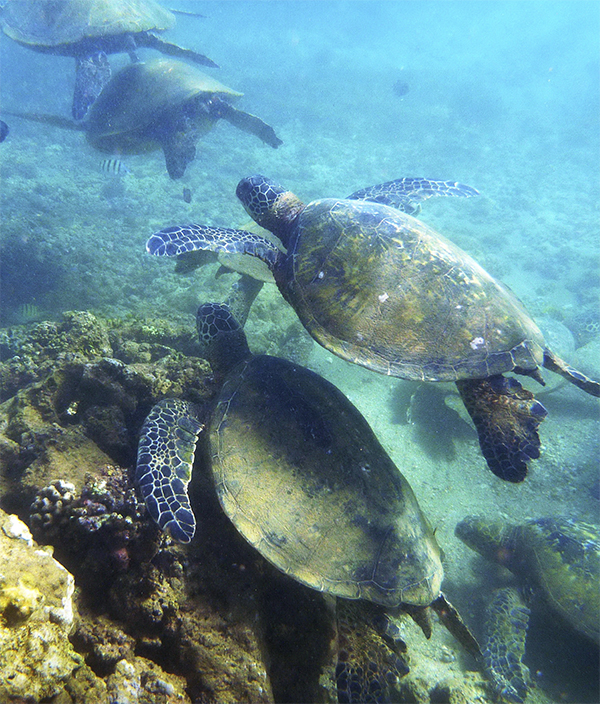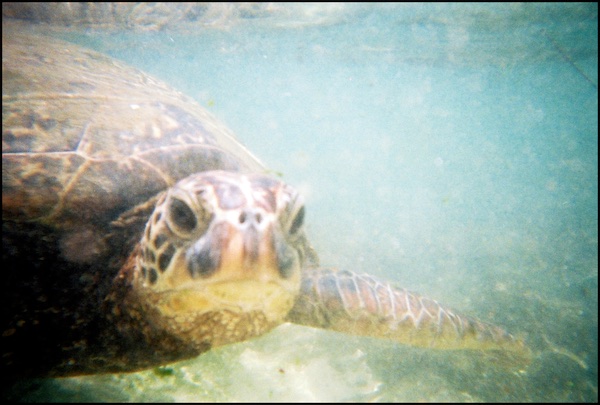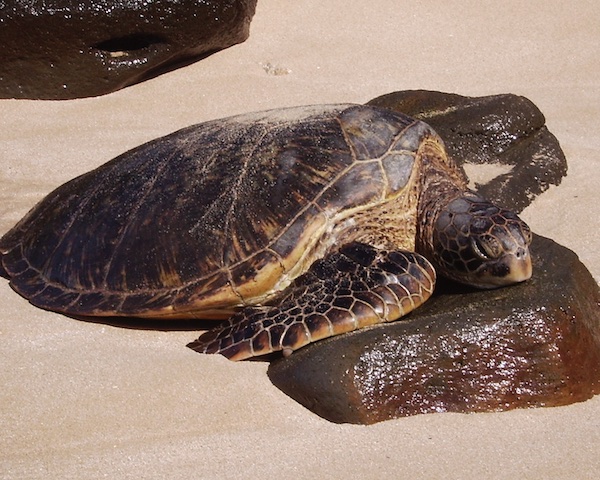Published in the Ocean Watch column, Honolulu Star-Advertiser © Susan Scott
December 14, 2015
 One photo, seven turtles. Oahu’s North Shore.
One photo, seven turtles. Oahu’s North Shore.
©2015 Susan Scott
‘Turtle! Turtle!”
The call came from our Palau guide during his rare turtle sightings, and usually the animal was 60 feet deep and departing. We Hawaii snorkelers in the group didn’t exactly shrug, but we’re so used to close encounters with tame turtles that seeing one disappearing in the distance was no big deal.
Turtles are so common around the main islands today that it’s reasonable to think the animals have recovered from the threat of extinction. But there’s more to recovery than head counts.
 Turtles encounters in Hawaii include them coming very close to examine what you’re up to.
Turtles encounters in Hawaii include them coming very close to examine what you’re up to.
© Scott R. Davis
In a 2014 paper published in the journal Biological Conservation, workers studied Hawaii’s ancient sites, market accounts, past menus and state records to determine the history of human impact on Hawaii’s turtles. The biologists divided their findings into three stages.
The first began with Polynesian settlers in about 1250. Archaeological digs show widespread turtle use among Hawaiian societies, which surely included egg collecting. Eventually, hunting pressure from a growing population destroyed most nesting areas in the main islands.
The second decline came with European contact in 1778. During the 1800s ship crews from Europe, North America and Asia killed turtles and collected eggs throughout the Northwest Hawaiian Islands for subsistence and commercial trade. By 1950 all turtle nesting areas in the northwestern chain were obliterated except for a single island in one atoll.
The final blow began in 1946. Due to a growing tourist industry, restaurant demand for turtle meat increased, and Hawaii’s government licensed turtle hunting. Because small coastal turtles were scarce by then, fishers moved to offshore areas where large, reproductive-age turtles swam. Turtle numbers finally got so low that the animals became protected under the Endangered Species Act in 1974, ending all legal hunting.
Protection works, and today the number of greens in Hawaii’s coastal areas is (arguably) about 61,000. But whether that’s close to or far from pre-hunting numbers no one can say.
Either way, this success story has a critical glitch. More than 90 percent of Hawaii’s turtles still nest only on that one tiny island 500 miles northwest of Oahu. This unnatural concentration means that the turtles are only one calamitous weather event, or one human-driven disaster, from losing their last egg-laying haven. That problem demands continued protection.
Nowhere have sea turtle numbers increased like they have in Hawaii, nor do turtles bask on beaches anywhere else in the world.
Sometimes it takes traveling to appreciate the splendor we have in our own backyards.
 A turtle basking on the North Shore of Oahu, using a rock as a pillow.
A turtle basking on the North Shore of Oahu, using a rock as a pillow.
© Scott R. Davis